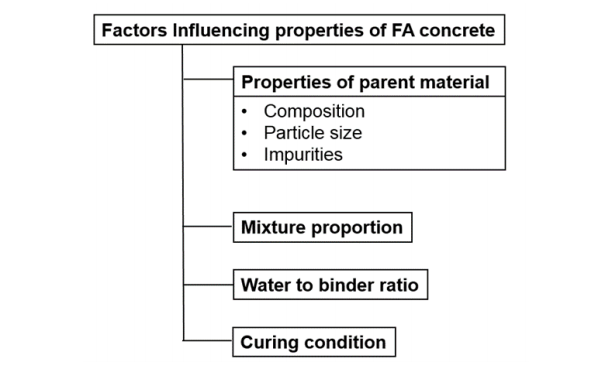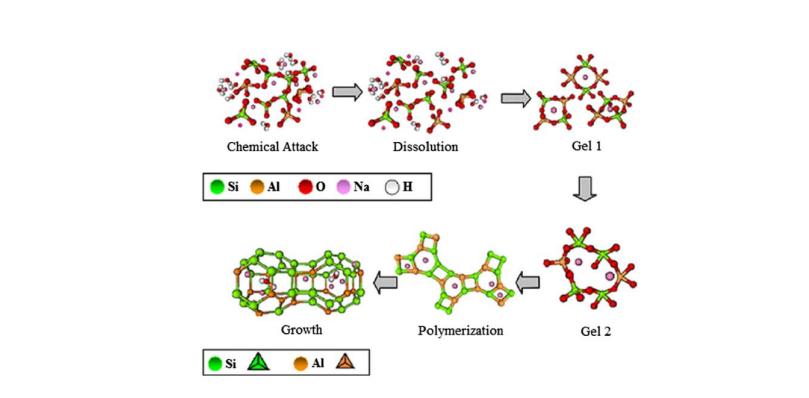In the recently published ‘3D printing of high-volume fly ash mixtures for digital concrete construction,’ Nanyang Technological University thesis student Biranchi Panda explores how fly ash-based geopolymers can be improved upon and used in 3D printing in construction.
 Concrete is one of the most widely used materials in the world, and contractors have a range of options to choose from today from materials that are fiber-reinforced, made with polymer, and even self-compacting. There are many benefits available with the use of SCC, including flowability, surface quality, durability, and more. Fabrication of complex geometries, however, is still challenging, requiring added expense and the need for more manpower.
Concrete is one of the most widely used materials in the world, and contractors have a range of options to choose from today from materials that are fiber-reinforced, made with polymer, and even self-compacting. There are many benefits available with the use of SCC, including flowability, surface quality, durability, and more. Fabrication of complex geometries, however, is still challenging, requiring added expense and the need for more manpower.
3D printing is not only getting attention from industrial users in the construction industry, but it is also quickly gaining traction as a faster, more affordable, and more versatile technology over convention methods. 3D printing systems usually consist of:
- Material mixing tank
- Material pumping system
- Extrusion system, featuring a printing head with a nozzle
- Control box with electronics
- Safety system
In comparison to computer-aided design (CAD), building information modeling (BIM) and a range of software tools, 3DCP offers advantages like better topology optimization, more versatile design opportunities, speed in manufacturing, and the ability to construct items that may not have been possible previously. This technology also offers the potential for diminishing the environmental impacts of 3D printing, another positive benefit, as currently, cement production accounts for five percent of global CO2 output.
Currently, fly ash-based sustainable materials are looking very attractive as they can produce 80 percent less CO2 output over ordinary Portland cement production—and, mechanical properties tend to be higher too.
“It is well known that thixotropy is one of the important properties in all 3D printing projects. PC has an inherent excellent thixotropy property due to flocculation and literature reveals that in the presence of any foreign materials like FA, sand, fillers, its colloidal network breaks down, thus resulting [in] loss of the thixotropy,” states Panda.
“One such example is high volume fly ash (HVFA) material which not only possesses low thixotropy but also slow hardening rate. Despite sustainability, poor early age mechanical properties limit its application for 3D printing projects.”
This issue caused Biranchi Panda to perform the current study, hoping to refine printability of HVFA binders and to understand more about HVFA cement and geopolymers overall. The first step considered by Panda was to create flowable extrusion materials that maintain their form throughout the process. With 3D printing, the process may occur right at the construction site or at another location, where prefabricated parts are put together and then transported for assembly.
“The choice of production again can be like regular wall elements or also can be optimized for minimizing the material wastage and construction cost,” states Panda.
Fine river sand was used for preparing mortar, as it is easily accessible in Singapore. Mixtures prepared by Panda and the research team were created to improve thixotropy, as they measured properties like compressive, flexural, and tensile strength. Microstructural analysis was also performed. Ultimately, Panda reports that the fly ash-cement was found to be ‘printable,’ although there were challenges in building strength in the HVFA material:
“Therefore, a very small amount (< 1%) of nanoclay (NC) was added to improve the early-age mechanical properties via enhancing the thixotropy at microstructure level. The effects of NC on thixotropy were tested for the first time with different shear rates and shearing time and it was found that compared to the control, the NC added mix has the potential to stabilize the viscosity recovery even after strong shearing for a longer time. Nevertheless, the effect of NC was not significant in increasing the strength gain rate (structural build-up), which is more controlled by the hydration reaction.”
Mechanical properties of the mortar were also affected by printing parameters, which is a common issue in digital fabrication. Greater bond strength was also reported in the geopolymer, in comparison to HVFA mortar.
“To maximize the benefit of rapid hardening like geopolymer, an in-line or continuous delivery system should be used instead of batch mixing, where the material can be mixed and deposit simultaneously. This will eliminate the difficulties in pumping due to change in material stiffness with time,” concluded Panda.
“Despite recent approaches to increase the ductility of printed concrete using microfiber, metal cable, post-tensioning rebars, the future application could be producing different fiber distribution in different layers, following the principle of functionally graded materials (FGM). 3D printing of FGMs would optimize the material usage and provide multi-functionally features for structural applications in building construction.”
The construction industry has been affected in many positive ways with the advent of 3D printing in the mainstream, from the building of offices and homes to the development of concrete printers on a large scale.
What do you think of this news? Let us know your thoughts! Join the discussion of this and other 3D printing topics at 3DPrintBoard.com.
[Source / Images: ‘3D printing of high-volume fly ash mixtures for digital concrete construction’]
Subscribe to Our Email Newsletter
Stay up-to-date on all the latest news from the 3D printing industry and receive information and offers from third party vendors.
You May Also Like
Further Understanding of 3D Printing Design at ADDITIV Design World
ADDITIV is back once again! This time, the virtual platform for additive manufacturing will be holding the first-ever edition of ADDITIV Design World on May 23rd from 9:00 AM –...
3D Printer Maker EVO-tech Reborn as NEVO3D — Once More With Feeling
EVO-tech was a 3D printing service and original equipment manufacturer established in 2013 and based in Schörfling am Attersee, Austria. The company produced high-quality material extrusion systems featuring linear bearings,...
3D Systems Brings 3D Printed PEEK Cranial Implant to the U.S. with FDA Clearance
For more than 10 years, 3D Systems (NYSE:DDD) has worked hand-in-hand with surgeons to plan over 150,000 patient-specific cases, and develop more than two million instruments and implants from its...
CDFAM Returns to Berlin for Second Annual Symposium
The second CDFAM Computational Design Symposium is scheduled for May 7-8, 2024, in Berlin, and will convene leading experts in computational design across all scales. Building upon the first event...



































